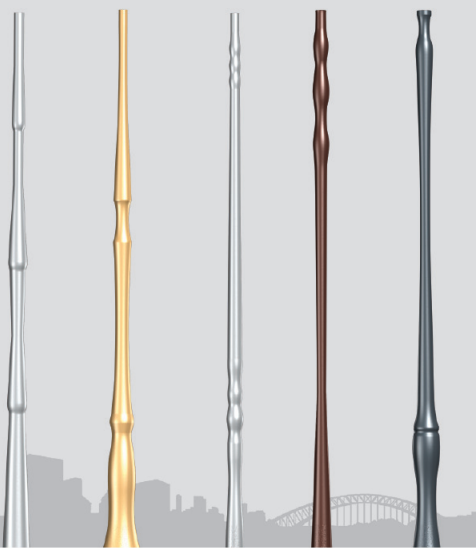Working principle of car generator Alternator structure 1. Structure of 6-tube alternator The structure of JF132 AC generator is shown in Figure 2-5c Two claw poles are press-fitted on the rotor shaft, and each of the two claw poles has six bird-shaped magnetic poles. The claw pole cavity is provided with a magnetic field winding (rotor coil) and a yoke. (Two) stator The stator core is composed of silicon steel sheets with slots in the inner ring, and the stator winding wires are embedded in the slots of the core. The structural parameters are as follows: Number of pole pairs p 6 pairs of stator slots z 36 slots stator winding phase number m 3 phases turns per coil N 13 turns winding connection method Y-type connection In the domestic JF13 series AC generator, a pair of magnetic poles account for The spatial position of 6 slots (60o electrical angle per slot), one magnetic pole occupies the spatial position of 3 slots, so the position interval of the two effective sides of each coil is 3 slots, between the beginning of adjacent coils of each phase winding The distance between them is 6 slots, and the distance between the starting sides of the three-phase winding can be 2 slots, 8 slots, 14 slots, etc. There is an output terminal B (the output end of the generator) on the positive rectifier board. (4) End cover The connection between the field winding (two brushes) and the generator is different, so that the generator is divided into two types: internal grounding type and external grounding type. Internal grounding type generator: a generator in which the negative brush of the field winding is directly grounded (directly connected to the housing). See Figure 2-13a Second, 8-tube alternator The basic structure of the 8-tube alternator (such as for Xiali vehicles) and the 6-tube alternator are the same. The difference is that the rectifier has 8 silicon rectifier diodes, 6 of which form a three-phase full wave bridge rectifier circuit There are 2 only neutral point diodes, 1 positive tube is connected between the neutral point and the positive electrode, and 1 negative tube is connected between the neutral point and the negative electrode. Full-wave rectification of the neutral point voltage. (See Figure 2-14) 3. 9-tube alternator (more applications for Japanese cars) The basic structure of the 9-tube alternator is the same as the 6-tube alternator, the difference is the rectifier. The rectifier of the 9-tube alternator is an alternator composed of 6 high-power rectifier diodes and 3 low-power excitation diodes. The role of the charging indicator is specifically introduced in the next section 4. 11-tube alternator (such as Santana car generator) as shown in Figure 2-17 5. Brushless alternator Because there are no brushes and slip rings, there will be no failures such as excitation instability or generator failure to generate electricity due to wear and poor contact of the brushes and slip rings; at the same time, there is no spark during operation, and radio interference is also reduced. 1. The structure and working principle of the claw pole type brushless alternator. The field winding of the claw pole type brushless alternator is stationary. It is fixed on the rear end cover by a yoke bracket, so the brush is no longer needed. Figure 2-19 shows a brushless alternator with an exciter produced by Bosch of Germany. It is actually a small silicon rectifier alternator specially designed for excitation based on a claw-pole three-phase alternator, which is called an exciter (4, 5, 6 in the figure). The magnetic field winding is fixed, while the three-phase winding is rotating. When the generator rotates, three-phase alternating current is induced in the three-phase winding of the exciter rotor 4, which is rectified by the diode inside the generator and becomes direct current, which is directly supplied to the field winding 15 of the claw-pole three-phase alternator. . At low speed, the contact K is closed, and the thyristor control pole obtains a positive trigger voltage and turns on. When the speed reaches a certain value, the rectifier bridge can provide a full-wave rectified voltage to the battery and the load. When the rectified output voltage rises above the rated voltage as the speed increases, the contact K opens (due to the increased suction of the coil), the thyristor cuts off due to the loss of the forward trigger voltage, and the rectified output voltage drops. When the rectified voltage drops to a certain value, the current in the coil of the voltage regulator decreases, the suction decreases, and K is closed. The three thyristors are triggered and turned on again, and the rectified output voltage rises again. Repeatedly, the output voltage can be controlled within the specified range. (Contact regulators have been replaced by electronic or computer-controlled regulators) 6. AC generator with pump The generator with pump alternator is exactly the same as the ordinary alternator, except that the rotor shaft is very long and protrudes from the rear end cover. The external spline is connected to the internal spline of the vacuum pump to drive the vacuum pump and the generator The rotor rotates synchronously to evacuate the vacuum cylinder in the brake system of the car and provide a vacuum source for the vacuum supercharger of the brake system. It is mainly used for diesel engines without a vacuum source (gasoline engines can directly obtain vacuum from the intake manifold. During braking, a high vacuum is formed in the intake manifold because the throttle valve is almost closed, while the diesel engine has no throttle valve). The shape of domestic JFB2525 pumped alternator is shown in Figure 2-21. 7. Automobile double rectifier generator The double rectifier generator is a newest type of alternator. It greatly improves the low-speed charging performance and high-speed maximum power output of ordinary alternators without adding more complicated control circuits, so it does not increase the failure rate of the charging system. 1. Structural principle As shown in Figure 2-22. On the basis that the three-phase of an ordinary alternator is fixed on the winding, increase the number of winding turns and lead out the terminal, and add a set of three-phase bridge rectifier. At low speeds, the original winding and the additional winding are output in series, while at higher speeds, only the original three-phase winding is output. The conversion of the high and low speed power supply circuit during work is automatic, without adding any electromechanical control device, and its working principle is analyzed as follows: Eight induction sub-alternator Induction sub-type alternator is also a brushless alternator, which is composed of stator, rotor, rectifier and casing. Its rotor is riveted from gear-shaped steel sheets, and there are several tooth-shaped salient poles evenly distributed along the circumference without magnetic field windings. The field winding and armature winding are placed in the stator slots, as shown in Figure 2-23.
The spinning pole is the use of foreign advanced spinning equipment,forming a whole without welding,forming a conical or profiled bar.And then polishing,remove surface oil,burr and indentation.Then after the quenching intensity,to T6 state,in line with international standards.The product never rust ,strong corrosion resistance,diversified surface treatment process,the appearance of simple fluid lines.Light weight and convenient installation and transportation,the rod body can be 100%recycling,low melting temperature.
Product features
â‘ Using spinning equipment advanced,the whole forming a non welding
â‘¡Product permanent does not rust,corrosion resistance
â‘¢Diversified surface treatment technology,make the appearance line succinct smooth
â‘£The light weight,convenient installation and transportation
⑤The rod body can be 100% recycling,melting temperature is low.
Aluminum Alloy Spinning Lighting Pole Aluminum Alloy Spinning Lighting Pole,Lightest Aluminum Alloy,Aluminum Alloy Torchlight,Lightweight Aluminum Alloy Jiangsu chengxu Electric Group Co., Ltd , http://www.chengxulighting.com
Alternator is generally composed of four parts: rotor, stator, rectifier and end cover.
JF132 type alternator assembly diagram is shown in Figure 2-5a 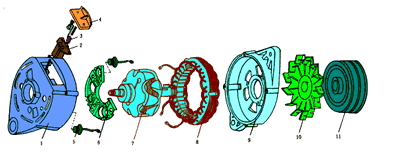
The structure of JF132 alternator is shown in Figure 2-5b 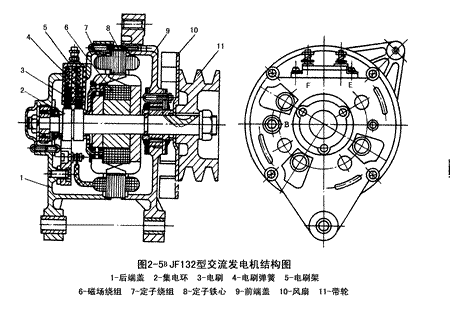
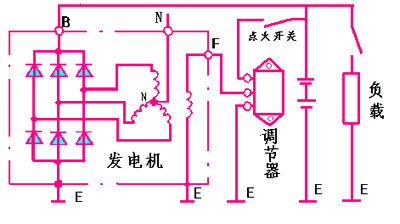
(1) Rotor
The function of the rotor is to generate a rotating magnetic field.
The rotor is composed of claw pole, yoke, magnetic field winding, slip ring, and rotor shaft, see Figure 2-6. 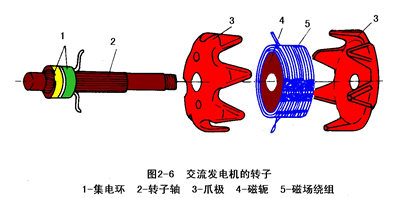
The collector ring is composed of two copper rings insulated from each other. The collector ring is press-fitted on the rotor shaft and insulated from the shaft. The two collector rings are respectively connected to both ends of the magnetic field winding.
When direct current is applied to the two slip rings (through the brush), current flows through the field windings and generates axial magnetic flux, which causes one of the claw poles to be magnetized to the N pole and the other to be magnetized to the S pole, thus forming Six pairs of interleaved magnetic poles. When the rotor turns, a rotating magnetic field is formed.
The magnetic circuit of the alternator is: yoke → N pole → air gap between rotor and stator → stator → air gap between stator and rotor → S pole → yoke. See Figure 2-7. 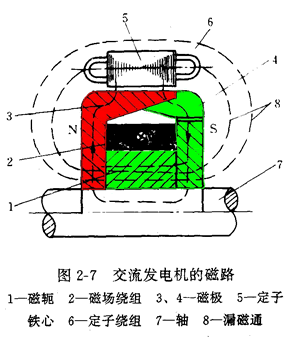
The function of the stator is to generate alternating current.
The stator consists of a stator core and stator windings. See Figure 2-8A 
The stator winding has three phases. The three-phase winding adopts star connection or delta (high power) connection, which can generate three-phase alternating current.
Three-phase windings must be wound according to certain requirements in order to obtain three-phase electromotive force with the same frequency, equal amplitude and 120 ° phase difference.
1. The distance between the two effective sides of each coil should be equal to the space distance occupied by one magnetic pole.
2. The distance between the beginning of the adjacent coil of each phase winding should be equal to or multiple of the distance occupied by a pair of magnetic poles.
3. The starting sides of the three-phase windings should be separated by 2Ï€ + 120o electrical angle (the space occupied by a pair of magnetic poles is 360o electrical angle)
Example: Winding of three-phase winding of domestic JF13 series AC generator is shown in Figure 2-8B 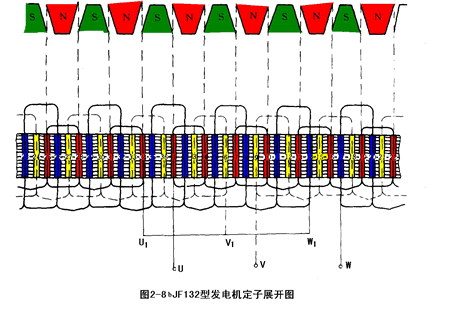
(3) Rectifier
The role of the alternator rectifier is to convert the three-phase alternating current of the stator winding into direct current,
The rectifier of the 6-tube alternator is composed of 6 silicon rectifier diodes to form a three-phase full-wave bridge rectifier circuit, and the 6 rectifier tubes are pressed (or welded) on two boards.
1. Characteristics of silicon rectifier diodes for automobiles (1) Large working current, forward average current 50A, surge current 600A;
(2) The reverse voltage is high, the reverse peak voltage is 270V, and the reverse peak voltage is 300V;
(3) Only one lead is shown in Figure 2-9. And some diode leads are positive, some diode leads are negative, the tube with the positive lead is called the positive tube, and the tube with the negative lead is called the negative tube, so the rectifier diode is divided into a positive diode and a negative diode. 
2. The installation of the rectifier tube installs the positive tube on an aluminum radiator plate, called positive rectifier plate; installs the negative tube on another aluminum radiator plate, called negative rectifier plate, and the generator back cover can also be used to replace the negative rectifier plate . See Figure 2-10. 
Connect the ground directly to the negative rectifier board. The negative rectifier plate must be connected to the housing.
The shape of the rectifier plate is different, there are horseshoe, rectangle, semi-circle, etc. See Figure 2-11 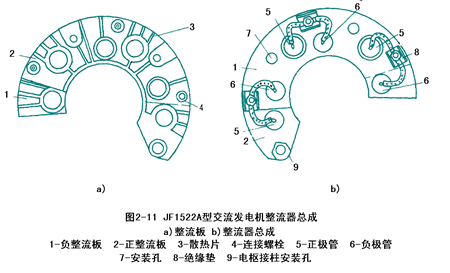
The end cover is generally divided into two parts (front end cover and rear end cover), which play the role of fixing the rotor, stator, rectifier and brush assembly. The end cover is generally cast with aluminum alloy. One is to effectively prevent magnetic leakage, and the other is that the aluminum alloy has good heat dissipation performance.
The rear end cover is provided with a brush assembly, which is composed of a brush, a brush holder and a brush spring. The role of the brush is to introduce the power supply into the magnetic field winding through the slip ring. See Figure 2-12 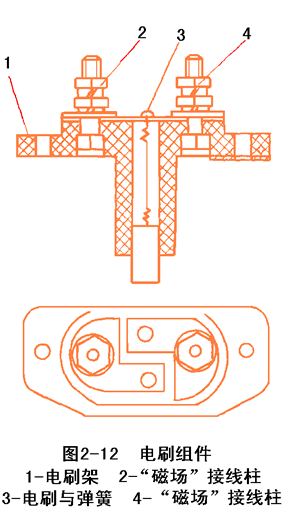

2. External ground generator: a generator in which the two brushes of the field winding are insulated from the housing. See Figure 2-13b 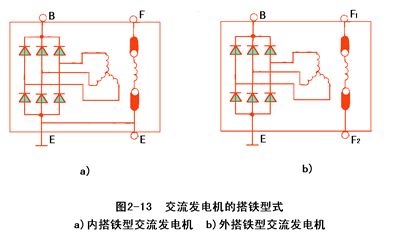
The negative pole (negative brush) of the field winding of the external ground-type generator is connected to the regulator, and then grounded after passing. 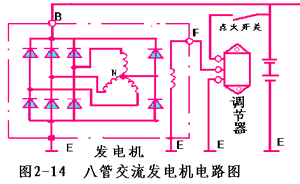
The test shows that the alternator with the neutral point diode can increase the power of the generator by 10% to 15% without changing the structure.
The principle of neutral point diode to increase generator power:
The neutral point voltage of the alternator is the third harmonic, and as the generator speed increases, the neutral point third harmonic voltage also increases. See Figure 2-15 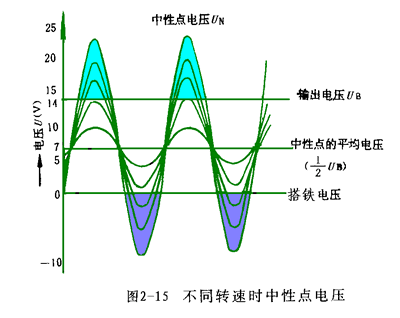
When the instantaneous value of the neutral point voltage is higher than the highest value of the three-phase winding, the neutral point positive tube is turned on to output current; the current loop is: neutral point → neutral point positive tube → load → a negative tube → stator winding → Neutral point. See Animation 2.
When the instantaneous value of the neutral point voltage is lower than the lowest value of the three-phase winding, the neutral point negative tube conducts external output current; current loop: neutral point → stator winding → a certain positive tube → load → neutral point negative tube → Neutral point. See Animation 2
Since the neutral point participates in the external output, the output power can be increased.
Among them, 6 high-power rectifier diodes constitute a three-phase full-wave bridge rectifier circuit, and three low-power tube diodes and three high-power negative-electrode tubes that supply power to external loads also form a three-phase full-wave bridge rectifier circuit specifically for powering the generator magnetic field. So we call 3 small power tubes as excitation diodes.
The 9-tube alternator circuit is shown in Figure 2-16 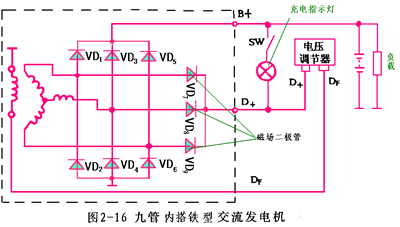
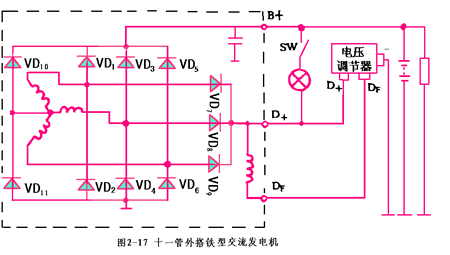
The rectifier of the 11-tube alternator is composed of 8 high-power rectifier diodes (including 2 neutral point diodes) and 3 magnetic field diodes. The other structure is the same as the 6-tube alternator.
Brushless alternators are divided into claw pole type, exciter type and permanent magnet type.
(1) Claw pole brushless alternator is shown in Figure 2-18 
Only one of the two claw poles is directly fixed on the rotor shaft of the motor, and the other claw pole is fixed on the former claw pole with a non-magnetic conductive coupling ring. When the rotor rotates, one claw pole drives the other claw pole to rotate together in the stator. When DC current passes through the field winding, the claw pole is magnetized, and a rotating magnetic field is formed. The magnetic circuit is shown in Figure 2-18
2. Advantages (1) Simple structure, convenient maintenance and reliable work (2) There is no power generation instability or non-power generation failure caused by poor contact between the brush and the slip ring.
3. Disadvantages (1) The connection process between the claw poles is difficult (2) Due to the increased gap in the magnetic circuit, the excitation current needs to be increased under the same output power of the generator.
(2) Exciter type brushless alternator is shown in Figure 2-19 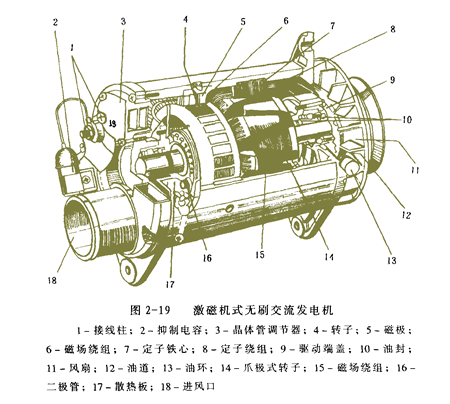
The advantage of this type of brushless generator is that there is no additional air gap in the magnetic circuit, so there is little magnetic leakage and high output power, but the structure is complex.
(3) Permanent magnet brushless alternator
The difference between this type of generator and the ordinary generator is the rotor part-the permanent magnet is used as the rotor magnetic pole to generate a rotating magnetic field, which not only removes the brushes and slip rings, but also does not require magnetic field windings and claw poles. The structure is simple and reliable, and the service life is long.
The permanent magnet materials commonly used in rotors are ferrite, chromium nickel cobalt, rare earth cobalt, neodymium iron boron and so on.
Due to the permanent magnet structure of the rotor, the strength of the rotating magnetic field generated is constant and unadjustable. Therefore, the output voltage of the generator cannot be adjusted by the method of controlling the magnetic field current of the ordinary alternator through the regulator. In order to solve the problem of voltage regulation, a method in which a voltage regulator is combined with a three-phase half-controlled bridge rectifier can be used so that the output voltage of the generator does not change with a large change in speed.
Figure 2-20 is a schematic diagram of the voltage control of a permanent magnet generator. Three common anode silicon diodes VD1, VD2, VD3 and three common cathode thyristors VT1, VT2, VT3 form a three-phase half-controlled bridge rectifier circuit. In addition, the three-phase full-wave rectifier circuit is composed of silicon rectifier diodes VD1 ~ VD6, which provides the trigger voltage for the thyristor control electrode, and is connected to one contact of the voltage regulator, and the other contact is connected to the control electrode of the thyristor Is connected in parallel to the output of the three-phase half-controlled bridge. The voltage control principle is as follows: 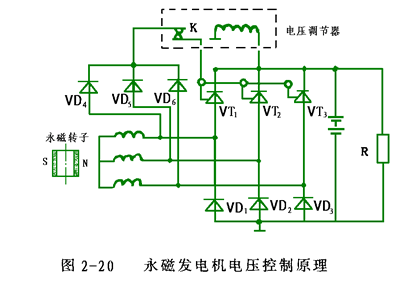
The advantages of permanent magnet alternator are as follows:
1. Small size, light weight, simple structure, convenient maintenance and long service life. Such as 750W titanium iron boron permanent magnet generator and 350W ordinary alternator weight. The rotor has no other wearing parts except the bearing and has ventilation holes, which has good cooling and heat dissipation, so the life can be increased by more than twice.
2. Because the transmission ratio is large, that is, the engine speed is low and the generator speed is high, the generator charging performance is good at low engine speed.
3. Large specific power can save metal materials.
4. No excitation loss, efficiency can be increased by more than 10%.
5. In the voltage controller, since only the current of about 10 mA of the control pole passes through the contacts, the contact wear can be reduced, and the voltage adjustment structure is very simple.
6. Since the magnetic permeability of the permanent magnet is close to the magnetic permeability of the air, the armature reaction magnetic resistance is increased, so the non-sinusoidal distortion of the induced potential is reduced, and the output power is increased. 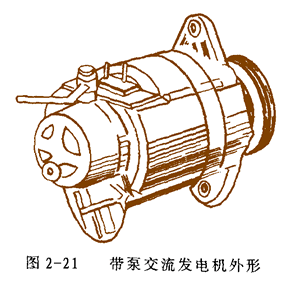
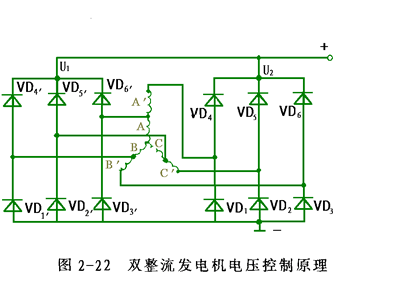
In the low speed range, due to the low speed of the generator, the series output of the three-phase windings increases the output voltage of the generator and greatly improves the low-speed charging performance of the generator. In the high-speed range, as the generator speed increases, the inductive reactance of the three-phase windings connected in series increases, the internal voltage drop increases, and the armature reaction strengthens, causing the output voltage to drop. At this time, the original three-phase windings A, B, and C have a relatively small internal voltage drop, and the induced current generated is relatively large, ensuring power output at high speed.
2. The advantages of dual rectifier generators are:
(1) Not only reduces the charging speed of the generator, but also ensures high-speed large-current output, and improves the effective power of the generator. The minimum charging speed of the double rectifier generator is 200-300r / min lower than that of the ordinary generator. The generator can output current up to 10A at low speed; and the speed under rated voltage and rated current is not more than 2500r / min.
(2) The structure is simple and the work is reliable. Only increase the number of winding turns in the stator slot and add a set of three-phase bridge rectifier. 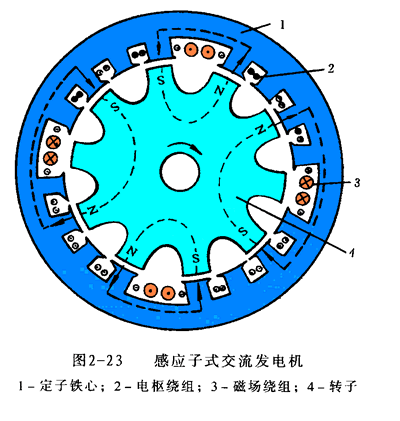
When direct current is applied to the field winding 3, a fixed magnetic field is generated in the stator core 1 (upper right and lower left are S poles; upper left and lower right are N poles). Since the magnetic flux of the convex tooth portion of the rotor 4 easily passes through, the magnetic induction intensity is the largest, thereby forming a magnetic pole. But each convex tooth of the rotor has no fixed polarity. When it faces the stator N pole, it is S pole, and when it faces S, it is N pole.
When the rotor convex teeth rotate in a non-moving magnetic field, when the convex teeth face the stator convex teeth, the magnetic flux is the largest, and when the rotor slot faces the walking convex teeth, the magnetic flux is the smallest. Therefore, when the rotor rotates, pulsating magnetic flux is generated in the convex teeth of the stator, and an alternating electromotive force is induced in the stator winding. The armature windings are connected in a certain way and rectified to obtain direct current.
The frequency of the AC electromotive force of the armature winding in the induction sub-alternator is always equal to Zn / 60 (Z is the number of rotor teeth and n is the rotor speed), which has nothing to do with the number of pairs of magnetic poles formed by the field winding, which is different from the essence of synchronous AC machine.
The induction sub-type brushless alternator machine has lower mass specific power. 